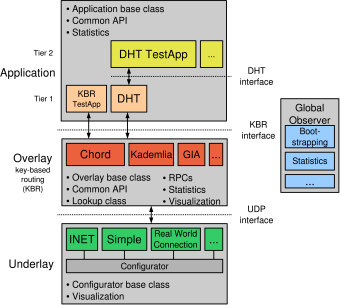| Version 20 (modified by , 19 years ago) ( diff ) |
|---|
OverSim Features
Some of the main features of our simulation framework OverSim include:

- Flexibility: The simulator allows to simulate both structured and unstructured overlay networks (currently Chord' and GIA are implemented). The modular design and usage of the Common API facilitate the extension with new features or protocols. Module behavior can easily be customized by specify parameters in a human readable configuration file.
- Interactive GUI: In order to validate and debug new or existing overlay protocols you can make use of the GUI of OMNeT++, which visualizes both the topology of the underlying network and the overlay topology in a customizable way.
- Exchangeable Underlying Network Models: Our simulation framework has a flexible underlying network scheme, which on the one hand provides a fully configurable network topology with realistic bandwidths, packet delays, and packet losses, and on the other hand a fast and simple alternative model for high simulation performance.
- Scalability: OverSim was designed with performance in mind. On a modern desktop PC a typical Chord network of 10,000 nodes can be simulated in real-time. We successfully simulated networks of up 100,000 nodes.
- Statistics: The simulator collects various statistical data such as sent, received, or forwarded network traffic per node, successful or unsuccessful packet delivery, and packet hop count.
Planned Features / Work in Progress
This is a list of features we're currently working on, which will be available in one of the next releases of OverSim:
- Additional overlay protocols: At the moment we're working on implementations of Kademlia, Koorde, Broose and as well as several Application Layer Multicast protocols.
- Additional applications: In the future we like to add new applications which make use of the overlay protocols like a DHT, Internet Indirection Infrastructure (i3) and traffic generators for multicast traffic.
- Reuse of simulation code: The different implementations of overlay protocols should be reusable for real network applications, so that researchers can validate the simulator framework results by comparing them to the results from real-world test networks like PlanetLab. Therefore, the simulation framework should be able to handle and assemble real network packets and to communicate with other implementations of the same overlay protocol.
Attachments (3)
- OverSimArchitecture.png (43.6 KB ) - added by 19 years ago.
- ScreenshotOverSim2.png (146.1 KB ) - added by 18 years ago.
- arch_small.png (75.9 KB ) - added by 17 years ago.
Download all attachments as: .zip
Note:
See TracWiki
for help on using the wiki.